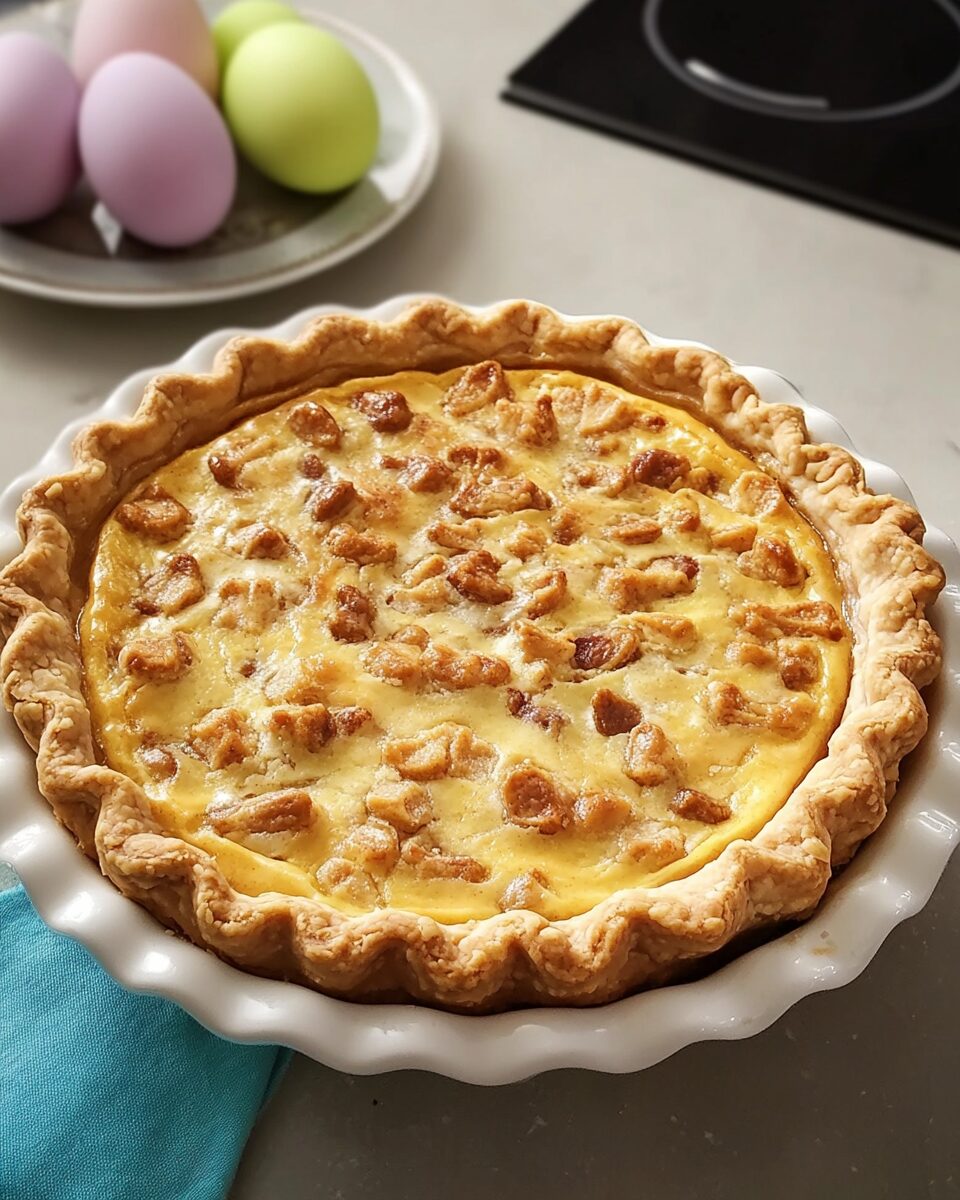This traditional Italian Easter Pie, also known as “Pastiera,” is a delightful dish featuring a rich filling of ricotta cheese, eggs, and a medley of meats and cheeses, all encased in a flaky pie crust. It’s a cherished recipe passed down through generations, perfect for celebrating Easter.
Full Recipe:
Ingredients
- 2 pounds ricotta cheese
- 6 large eggs
- 1 pound cooked ham, chopped
- ½ pound Genoa salami, chopped
- ½ pound mozzarella cheese, grated
- ¼ pound prosciutto, chopped
- 4 (9-inch) unbaked pie crusts
- ¼ cup grated Parmesan cheese
Directions
- Preheat Oven: Preheat the oven to 325°F (165°C).
- Prepare Filling: In a large mixing bowl, place the ricotta cheese. Beat in the eggs one at a time using an electric mixer on low speed. Stir in the chopped ham, salami, grated mozzarella, and prosciutto until well combined.
- Assemble Pies: Line two 9-inch pie pans with the unbaked pie crusts. Divide the ricotta mixture evenly between the two pans. Sprinkle each pie with grated Parmesan cheese. Cover each pie with a top crust, crimp the edges to seal, and cut steam vents in the tops.
- Bake: Place the pies in the preheated oven and bake until the crusts are golden brown, about 1 hour. Once baked, remove from the oven and cool on wire racks.
Nutritional Facts (per serving)
- Calories: 727
- Total Fat: 51g
- Saturated Fat: 20g
- Cholesterol: 194mg
- Sodium: 1602mg
- Total Carbohydrates: 31g
- Dietary Fiber: 2g
- Sugars: 1g
- Protein: 34g
History and Cultural Significance
Easter Pie dates back to ancient times when Italians incorporated eggs into dishes to symbolize rebirth and new beginnings. It has origins in Southern Italy, particularly in Naples, where families would prepare this pie as part of their Easter feast. Each region in Italy has its variation of the dish, with some leaning toward a sweeter ricotta-based filling, while others embrace a hearty, savory combination of meats and cheeses.
The pie’s purpose was to celebrate the end of Lent, a 40-day period of fasting and abstinence. Since many traditional Italian households refrained from eating meat and dairy during Lent, Easter Pie became a highly anticipated treat, packed with indulgent ingredients to mark the special occasion. Today, it remains a staple at Easter tables, enjoyed warm or at room temperature, often accompanied by fresh salads, wine, and other festive dishes.
The Unique Composition of Easter Pie
Unlike many other pies, Easter Pie stands out due to its blend of both sweet and savory flavors. The filling is a rich, creamy mixture of ricotta cheese, eggs, and a variety of cured meats like ham, salami, and prosciutto. The cheeses—often a mix of mozzarella, Parmesan, and sometimes provolone—add depth and texture to the pie, creating a satisfying balance of flavors.
The crust, typically made from a simple dough of flour, butter, eggs, and sometimes a hint of sugar, provides a sturdy, flaky base that encases the flavorful filling. Some families choose to create a lattice-style top crust, similar to a fruit pie, which allows for slight ventilation while adding an elegant, decorative touch.
Variations of Easter Pie
Although the traditional recipe remains popular, there are many regional and modern adaptations of Easter Pie. Some families prefer a lighter version by incorporating spinach or other leafy greens, while others substitute different meats and cheeses depending on availability and preference.
- Neapolitan Pastiera – A sweeter version of Easter Pie that includes wheat berries, orange zest, and cinnamon, giving it a fragrant and slightly sweet taste.
- Calabrese Easter Pie – A heartier version packed with spicy soppressata sausage and hard-boiled eggs, adding extra layers of texture.
- Vegetarian Easter Pie – A modern twist that replaces meats with sautéed greens, mushrooms, and sun-dried tomatoes for a more plant-based approach.
Why Easter Pie Is a Must-Have for Your Easter Table
Easter Pie is not just about taste—it’s about tradition, togetherness, and celebration. It embodies the essence of Italian hospitality, where food plays a central role in bringing people together. Whether served as an appetizer, a main course, or even a snack, Easter Pie adds a comforting, homemade touch to any gathering.
Beyond its cultural roots, this dish is incredibly versatile. It can be prepared ahead of time, making it an excellent option for large family meals or potlucks. Since it can be enjoyed warm or cold, it also makes for a great picnic food during springtime festivities.
Tips for the Perfect Easter Pie
- Use High-Quality Ricotta: Fresh ricotta cheese makes all the difference, giving the filling a creamy and smooth texture.
- Balance the Meat and Cheese: Too much cured meat can overpower the pie, so use a balanced mix of flavors.
- Let It Cool Before Serving: Allowing the pie to cool helps it set properly and enhances the flavors.
- Experiment with Herbs and Spices: Adding black pepper, fresh parsley, or a dash of nutmeg can elevate the taste.
Symbolism of Easter Pie
Easter Pie, also known as “Pizza Rustica” or “Pastiera,” is deeply connected to the Easter holiday because it embodies the themes of renewal, abundance, and family togetherness. Easter is one of the most significant religious celebrations in Christianity, marking the resurrection of Jesus Christ. Many foods associated with Easter, including Easter Pie, have symbolic meanings tied to this spiritual event.
Regional Traditions and Variations
In Naples, where one of the most famous versions of Easter Pie—Pastiera Napoletana—originated, the dish has a distinct sweet profile. This variation includes wheat berries, ricotta, orange zest, and cinnamon, making it a fragrant and slightly sweet dessert rather than a savory pie. The ingredients reflect both ancient Roman and Christian traditions, with wheat representing prosperity and citrus fruits symbolizing the freshness of spring.
A Feast to End Lent
The tradition of Easter Pie is particularly strong in Italian culture, where Easter is a grand celebration filled with food and family gatherings. In Italy, preparing special dishes for Easter Sunday is a way to honor the end of Lent and to express gratitude for the blessings of the season. Easter Pie fits perfectly into this feast, as it is rich, filling, and capable of feeding a large family.
Conclusion
Grandma’s Easter Pie is more than just a recipe—it’s a tradition that tells a story of family, history, and celebration. This savory Italian classic has stood the test of time, evolving with each generation while remaining a beloved centerpiece at Easter gatherings.






